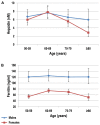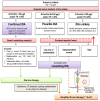Iron deficiency in the elderly population, revisited in the hepcidin era
- PMID: 24795637
- PMCID: PMC4006029
- DOI: 10.3389/fphar.2014.00083
Iron deficiency in the elderly population, revisited in the hepcidin era
Abstract
Iron deficiency (ID) is relatively common among the elderly population, contributing substantially to the high prevalence of anemia observed in the last decades of life, which in turn has important implications both on quality of life and on survival. In elderly subjects, ID is often multifactorial, i.e., due to multiple concurring causes, including inadequate dietary intake or absorption, occult bleeding, medications. Moreover, because of the typical multimorbidity of aged people, other conditions leading to anemia frequently coexist and make diagnosis of ID particularly challenging. Treatment of ID is also problematic in elderly, since response to oral iron is often slow, with a substantial fraction of patients showing refractoriness and requiring cumbersome intravenous administration. In the last decade, the discovery of the iron regulatory hormone hepcidin has revolutionized our understanding of iron pathophysiology. In this review, we revisit ID among elderly people in the light of the impressive recent advances on knowledge of iron regulation, and discuss how hepcidin may help in diagnosis and treatment of this common clinical condition.
Keywords: anemia; elderly; ferritin; hepcidin; iron deficiency.
Figures



Similar articles
-
Acquired Refractory Iron Deficiency Anemia.Mediterr J Hematol Infect Dis. 2021 May 1;13(1):e2021028. doi: 10.4084/MJHID.2021.028. eCollection 2021. Mediterr J Hematol Infect Dis. 2021. PMID: 34007416 Free PMC article. Review.
-
Anemia and Iron Deficiency in Cancer Patients: Role of Iron Replacement Therapy.Pharmaceuticals (Basel). 2018 Sep 30;11(4):94. doi: 10.3390/ph11040094. Pharmaceuticals (Basel). 2018. PMID: 30274354 Free PMC article. Review.
-
[Effect of iron deficiency level on oral iron absorption].Zhonghua Xue Ye Xue Za Zhi. 2021 May 14;42(5):402-406. doi: 10.3760/cma.j.issn.0253-2727.2021.05.009. Zhonghua Xue Ye Xue Za Zhi. 2021. PMID: 34218583 Free PMC article. Chinese.
-
Baseline hepcidin measurement in the differential diagnosis of anaemia for elderly patients and its correlation with the increment of transferrin saturation following an oral iron absorption test.Clin Chem Lab Med. 2018 Dec 19;57(2):250-258. doi: 10.1515/cclm-2018-0551. Clin Chem Lab Med. 2018. PMID: 30055098
-
The changing landscape of iron deficiency.Mol Aspects Med. 2020 Oct;75:100861. doi: 10.1016/j.mam.2020.100861. Epub 2020 May 14. Mol Aspects Med. 2020. PMID: 32418671 Review.
Cited by
-
British Society of Gastroenterology guidelines for the management of iron deficiency anaemia in adults.Gut. 2021 Nov;70(11):2030-2051. doi: 10.1136/gutjnl-2021-325210. Epub 2021 Sep 8. Gut. 2021. PMID: 34497146 Free PMC article.
-
Delayed Bone Age and Osteoprotegerin Levels in Pediatric Celiac Disease: A Three-Year Case-Control Study.Nutrients. 2025 Jul 11;17(14):2295. doi: 10.3390/nu17142295. Nutrients. 2025. PMID: 40732920 Free PMC article.
-
Hepcidin in the diagnosis of iron disorders.Blood. 2016 Jun 9;127(23):2809-13. doi: 10.1182/blood-2015-12-639112. Epub 2016 Apr 4. Blood. 2016. PMID: 27044621 Free PMC article. Review.
-
Age-Related Changes and Sex-Related Differences in Brain Iron Metabolism.Nutrients. 2020 Aug 27;12(9):2601. doi: 10.3390/nu12092601. Nutrients. 2020. PMID: 32867052 Free PMC article. Review.
-
Assessment of the Predictive Factors Influencing the Diagnosis and Severity of Villous Atrophy in Patients with Celiac Disease and Iron Deficiency Anemia Referred for Diagnostic Endoscopy in Basrah, Iraq.Med J Islam Repub Iran. 2022 Mar 12;36:20. doi: 10.47176/mjiri.36.20. eCollection 2022. Med J Islam Repub Iran. 2022. PMID: 35999917 Free PMC article.
References
Publication types
LinkOut - more resources
Full Text Sources
Other Literature Sources
Medical

